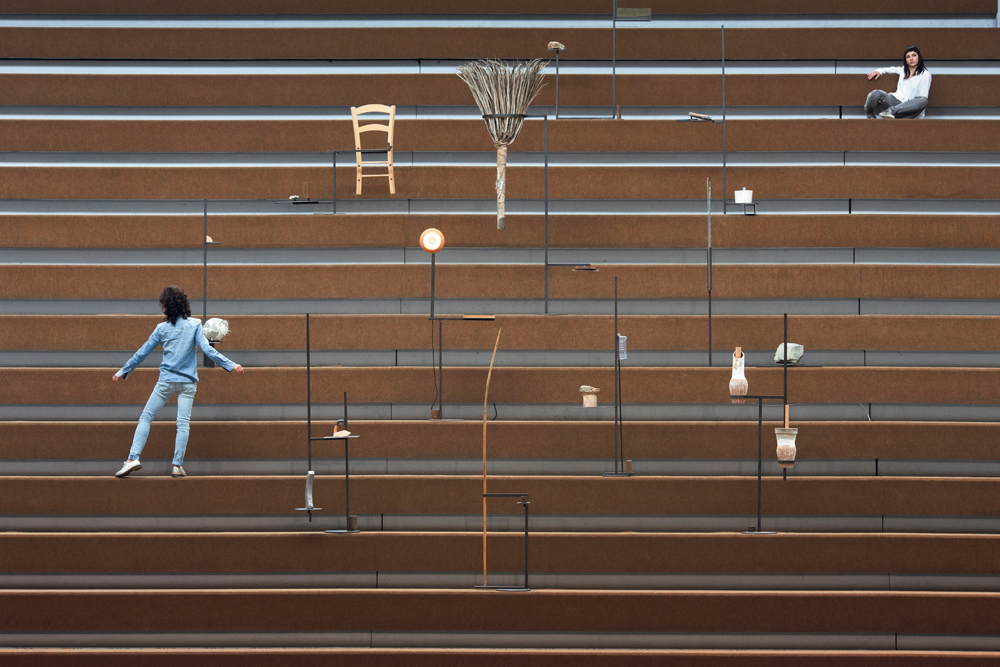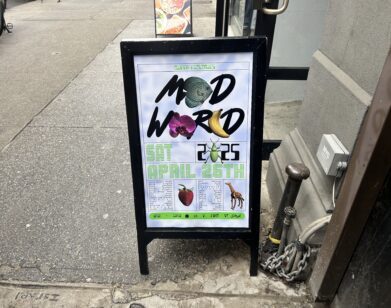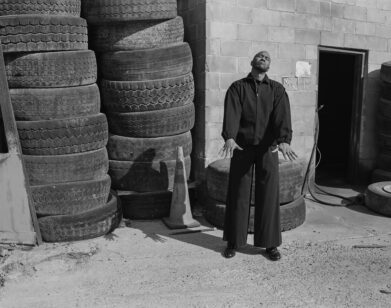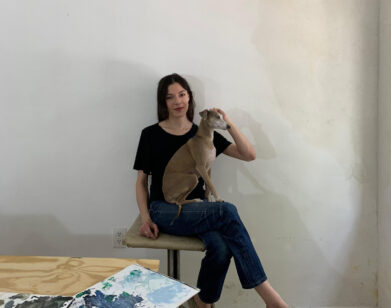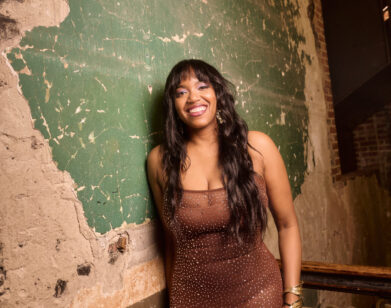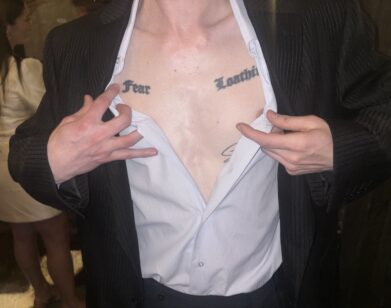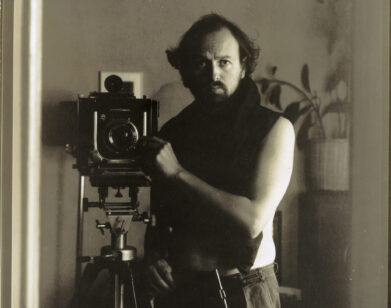Maria Hassabi
It would surprise no one that the most provocative art in New York this spring will be exhibited at the Museum of Modern Art. But what might come as a shock is that it will appear not in the museum’s galleries but in its stairwells and atrium. That’s because, for 29 days, the 42-year-old artist and choreographer Maria Hassabi is unleashing her latest project, Plastic, on the in-between spaces of the institution; here, she and her performers will move in choreographed states of tension, distortion, and extreme physical slowness.
Stillness and slowness are hallmarks of Hassabi’s recent performance pieces, and they are liberating and anguishing to watch. In one sense, they jam our current reality of time on overdrive—a Paul Virilio-esque hyper-obsession with speed and technology (faster being the selling agent of today’s experiences). The fact that the Cyprus-born artist is staging Plastic in zones devised for public conveyance further clashes with our understanding of what it means to arrive. But Hassabi’s work doesn’t simply serve as counterpunches to our ADD-driven acceleration culture. After years of working on projects that homed in on the brutal romance of downtown New York in the early 2000s, the artist formulated a far more paired-down formalist vocabulary. There is the almost minimal elegance of an Agnes Martin or Barnett Newman painting to her productions, but one that never loses the sense that her material is the human body, the muscular, warm-blooded vertebrate form. Thus, what seems like very simple gestures in theory-making direct eye contact for nearly an hour while enacting a series of calibrated poses, as she did in her 2010 piece Robert and Maria—becomes waylaid by emotional and psychological duress. The audience becomes prisoner, voyeur, witness, bystander, and ultimately (as all great art should do) collaborator in the investment. Hassabi, who still lives part time in New York, is one of the most interesting and exceptional artists of her generation. I spoke with her by phone this past January, where she was in Brussels rehearsing for the MoMA show.
CHRISTOPHER BOLLEN: Of all art forms, dance and performance might be the one least shackled by questions of regionalism or dialects. But I did want to ask you about growing up in Cyprus.
MARIA HASSABI: I was born in Nicosia. But when I was 2 years old, I moved to Dubai for about six years, then back to Nicosia. So I grew up in both places.
BOLLEN: But I specifically was curious about how the Green Line—the Berlin Wall-like separation between the Greek and Turkish sides of the island—impacted you as a child.
HASSABI: I’m not sure exactly. I think the kids of my generation, we had a lot of nightmares. It’s not like we understood what was happening. But the Green Line was very close to the house where I grew up. And there was almost like a phantom on the other side—as kids we have no idea. We didn’t know what was going on on the other side.
BOLLEN: And there was no crossing?
HASSABI: No, not then. It opened up more after I left, but I moved to Los Angeles when I was 16, so I wasn’t really present for all of the political changes that have happened since. I have such a thick accent still, but I don’t have as many ties to Cyprus.
BOLLEN: I just wondered if growing up in a divided city had anything to do, even subconsciously, with your interest in the restrictions and tensions of the human body. I might be taking this biography idea a bit far. [laughs]
HASSABI: I’m sure subconsciously there is. I have said jokingly that growing up with such a strict line around you, you become more of a formalist. But I also went to CalArts, so that might have more to do with it.
BOLLEN: Did you go to CalArts specifically for performance?
HASSABI: Yeah. But then being at CalArts, I ended up being very much around visual art. Most of my friends came from that department.
BOLLEN: Looking back on your work, I kept thinking that Pina Bausch might have been a big early influence.
HASSABI: My inspirations keep changing. But, yes, Pina Bausch was a big inspiration. I first saw her when I was in my early teens, when they came to perform at this big, beautiful theater in Athens. I was blown away. In CalArts I was more influenced by what was happened at Judson Church [New York’s Judson Memorial Church, home and namesake of the avant-garde dance collective, Judson Dance Theater, 1962-64]. And then when I moved to New York in 1994, I was more interested in my contemporaries, the people around me who were making work at the moment, much more so than previous generations. My friends were more visual artists, so I went to openings and followed art closely. Also at that time in New York, it was a big mix, but in terms of the art world, dance wasn’t a very alive form. I was very active in downtown dance in New York, but that felt very much in its own little box.
BOLLEN: Right. Judson Church and folks like Yvonne Rainer broke down so many of those barriers separating dance and visual, object-based art, and it seems like the walls went right back up again by the ’80s. In my mind, the art world of the ’90s felt particularly absent of performance work. Video art, yes. Dance, no.
HASSABI: It was completely closed off. There was a lot of dance happening in New York, but it was in its own world. Of course, you would go and see your friends’ shows and they’d come and see yours.
BOLLEN: But really it wasn’t until Performa started that you felt like the art world was tracking performance.
HASSABI: Well, Performa really blew this whole thing wide open and made it very, very present.
BOLLEN: I know fashion has been important to you, and there is an element of fashion in your work—although it’s incorporated in such a way I can’t even call out how.
HASSABI: It’s also another thing that came as an influence from my friends. It’s the same with art. Most of my friends have been visual artists or fashion designers, so I can’t help it. It was part of the conversations I had. But personally, I always felt that dressing up was such an important part of image-making. It’s so much a part of social status as well.
BOLLEN: When you’re working a piece, how much attention goes into the clothing the performers are wearing? Is it part of the initial visual in your mind or chosen at the end?
HASSABI: Well, since about 2009, when I started wearing denim in my work, that’s made it a bit more simple. But even when I know its denim, there’s the question of color and styling.
BOLLEN: Why denim? Did it seem like a neutral fabric?
HASSABI: It felt natural and very human and going away from this idea of dancers always in tights. I want the performers to very much have the feeling of everyday people.
BOLLEN: And the leotard classifies it too much as a dance from the outset.
HASSABI: It can be beautiful. There’s one piece of Merce Cunningham’s where they’re all wearing simple leotards of different colors. It’s gorgeous to see. But it’s not the direction I wanted to go.
BOLLEN: When I was looking back on your career, it felt to me that there was a division between the work you were doing in the early to mid-2000s and the pieces from the last seven or eight years. Would you disagree with that?
HASSABI: No, I agree. It started in 2007 with my piece Gloria and then really much more defined with Solo and SoloShow in 2009. I think before these works, I was more interested in imitating the rhythm of the city and getting the sense of all my friends and the music and the clothing and everything that was happening all around me.
BOLLEN: You were looking more outward then. There are pieces like 2006’s Still Smoking that feel very much like a tableaux of downtown New York at the time—that strangeness and seduction and toughness.
HASSABI: And also Dead Is Dead in 2004, which was the first big piece I did in New York. We had so many people help, like Dash [Snow] and his crew came and did the graffiti on the walls in the back of the theater. That was amazing. It was in the old DTW [Dance Theater Workshop] that’s now New York Live Arts. And with all these graffiti kids coming and going, people couldn’t stay in their offices to work. [laughs] So that was about community. And gradually I kind of went off on my own way.
BOLLEN: Was that a natural progression or a decision to step away from that earlier work?
HASSABI: There was an attraction to image-based material in my work. And then I just went all the way there. And by image, I mean that it took me awhile to understand how I was going to support image-based work that did not rely on easy theatrical tricks like change of light or change of costume. And that’s when the stillness started coming more and more into my work—the effect of stillness and how you transfer from one pose of stillness to the next, without making it look like a tableau vivant but keeping it a consistent flow.
BOLLEN: I want to talk about stillness and slowness. The immediate corollary is speed and the fastness of technology. We don’t really experience slowness anymore in our interactions. Even paintings today look fast. It’s such a scarcity in our current climate, so I wonder if it was actually harder for you—emotionally, mentally—to do the work required for slowness. Because we as people don’t even work slow anymore.
HASSABI: We don’t work slow, and I’m pretty fast too. I walk really fast. I do lots of things really fast. It’s not my natural response to be slow, unless I’m on the beach and the sun is really hot. But it was a response—I wanted more time to see and be with things. And I could not ask other people to go more slowly to let me look at them, or to let me be with an art piece longer, so I had to do it in my own work.
BOLLEN: I’m curious, how do you prepare for stillness? Does your heart rate have to drop?
HASSABI: In theater it is very different than when I’m doing museum or gallery work. Gallery work is there all day long, which I call live installations. In theater, the amazing thing that happens is that your adrenalin is so high because the audience is there. It generally makes your heartbeat fast, and you’re moving slow, and you’re holding a position for x amount of minutes, and your body starts twitching. And the adrenalin can take an hour to go away. In a normal dance performance, when you’re moving normally, there’s adrenalin for the first five minutes and then it goes out of your body. With stillness and slowness, it stays with you. So it becomes very much part of the choreography, these twitches and tears coming from the eyes, and people think, “Oh, we’re just being dramatic.” But it’s just physical reactions of the body.
BOLLEN: I did yoga once—once. And my entire nervous system was on the edge of collapse. I couldn’t stop shaking by trying to hold the poses.
HASSABI: The other thing that’s interesting is what it is we’re portraying. So there’s an inner dialogue you have with yourself. You’re not just holding a position and feeling it internally—you’re also concerned with what you’re projecting outside as a shape, a mold. So, as a performer, it’s not only about how you’re feeling inside.
BOLLEN: Let’s talk about these almost intervention-like performances that you did at the Venice Biennale in 2013 or here at MoMA with Plastic. Is the relationship to the audience different when that observer is more of a bystander than in a more conventional setting? All of your pieces are choreographed, but do you shift them depending on your interaction with the viewer?
HASSABI: There’s always a strict script, so we have to remain honest to the script. Because there are so many cues among the performers or among the sound or lights or whatever. But there are reactions by the visitor of the museum that are beyond whatever we choreographed and scripted in advance. So we have to respond without letting go of the structure of the work.
BOLLEN: How strict is that structure? You’re rehearsing Plastic now. Is it a case where every single breath, every move is set?
HASSABI: I hope so, but I don’t think that’s 100 percent possible. But that’s the beautiful thing about live performance—things happen right in the moment that you cannot know. Like we say, “Okay, when you hold this position, you take five deep breaths.” But let’s say I cough in the middle, so there it goes [laughs] two breaths of that. Now that’s a silly example. But maybe somebody comes and sits next to you and doesn’t let you move to the right because they’re sitting to the right of you. So you’re going to have to delay that until the visitor moves. Maybe say something to them: “Can you please move?” And that takes you a little bit out of your script. But you know the script well, so even if you make changes, you know how to catch up.
BOLLEN: How much does the setting matter? You performed Show [2011] in a theater, and then you actually brought it down to Wall Street and performed it on the street. Does that utterly transform the piece?
HASSABI: Yes. That particular piece was made with the audience being around us. It was made for a theater. But it was built very three-dimensionally, so it’s one of the works that is easy to place in many different contexts. We’ve performed that work by the sea. We’ve performed it in a sculpture garden, in Wall Street, in galleries, in theaters. It does change every time what the work is about. But it doesn’t really because of its reason and the relationship that me and the other performer, Hristoula Harakas, have between us; it’s so tight. And what you end up remembering from the work—it is the sculpture that we create between us and the rhythm of the work, the slowness. And placing it in a space like Wall Street, where everybody’s moving so fast and they don’t even look at anything, is going to make the work stand out even more than in a theater. I very much like placing my work in a different context. And architecture is really important. So even most of the works that I create for theater, they play with the idea of what theater is: the space of theater, the audience, the relation between audience and performer and such. When I went to Venice, I went much earlier to see the space. I chose to do it on the bleachers of the gymnasium. The title Intermission came into my mind, like, the break of watching sports let’s say. And when we first did Plastic at the Hammer; the work was very, very much adapted to the architecture of the Hammer Museum in L.A., and then now at MoMA it’s changing because of how the museum is.
BOLLEN: Would you say it interacts with the art that’s there as well? You’ve previously done work based on the poses of women in art history and pop culture. Are you addressing the female body in the museum?
HASSABI: Well, it is because it’s part of my vocabulary, but this piece is not specified in that way. The work is so much more about using liminal spaces. So we’re not in conversation. We’re not in conversation with other art works that are in the museum because we are not in the gallery spaces for Plastic. We’re in the stairs or the balconies or the atrium, spaces that you use to get somewhere, to see the art.
BOLLEN: So there’s a level of surprise on the part of the audience.
HASSABI: Sure. Except a place like Wall Street is completely a public space. MoMA is one of the most prestigious museums. So even though we’re not in a gallery space, still someone has invited us to be there. [laughs] I couldn’t be doing a guerilla performance for that long; I’ve done that at MoMA before.
BOLLEN: Wait. You’ve done a guerilla performance at MoMA before?
HASSABI: Yes. [laughs] It’s this piece called The Ladies [2012]. It’s a film actually, not a live performance, but it takes place as a performance. Women split into pairs and they walk around the city. They walk around very slow but not in slow motion. And they wear black clothes, black sunglasses, bright lipstick and they have their hair pulled back. And they walk into MoMA a few times. Sometimes they were asked to leave and sometimes nobody realized we were doing an art piece in there. The camera was completely camouflaged on a shirt so nobody knew we were filming. You only could see these two girls walking around basically very slow and stopping, lying on the floor, sitting on the staircases, in the garden. Plastic is not like that.
BOLLEN: Robert and Maria is one of your most epic works—you and Robert Steijn holding a stare for almost all of the hour-long performance.
HASSABI: Robert and I met a long time ago and decided we wanted to work together. We would always meet and talk about this collaboration we’d do one day. And then we ended up getting a show together. When we started working, there were so many ideas that we wanted to explore. And slowly we threw everything away and we stayed with this relationship of looking at each other in the eyes and seeing what that would bring—again, with the idea of sculpture and the idea of images and being very aware of our physique as two people. We also wanted to be present and surprise ourselves.
BOLLEN: In many ways, a locked stare is such a romantic gesture.
HASSABI: It is. But again, there is a structure, a script that we spoke about.
BOLLEN: How do you feel about the renewed cultural interest in performance in the past decade? Older artists are being asked to re-stage earlier performance pieces. And there’s a young crop of performance artists who are now so fostered by the art world. Why do you think there’s this return to the form?
HASSABI: It’s exciting, this live aspect. Whether it’s fashionable or not, I’m not so sure. But I’m still fond of the visual arts, also, so I don’t see it as a conflict. I see as many shows as possible because it’s a part of my work. Although it’s not always easy for me to make the time. For instance, now, rehearsing for Plastic, I have to be at the theater from this time to that time to work on the show. It used to be the most beautiful thing for me; I loved so much to go to the theater, close the doors, and we’re in here and we’re watching. But at some moment, it became very claustrophobic for me. I love the openness, having the freedom to go in and out, and going to see static work or performance work on my own. [laughs] That’s really rude what I’m saying.
BOLLEN: No, it makes perfect sense. Only I imagine that static artists—painters and sculptors and the like—might be jealous of your arrangement. So many painters I know are completely disconnected from their audience. They finish a painting, it leaves the studio, and they don’t really participate in its movement through the world. It sort of disappears from their lives. Maybe they go to their opening, but that’s about it. You, however, are right up against the audience’s immediate reaction.
HASSABI: In a very capitalist way, it’s a great benefit that a visual artist has, to be done with a work. It’s not theirs anymore. On they go to the next one. And yes, with us, we cannot do that. You’re staying there. You’re there until your work is done. And once you’re done, nobody else is seeing it. There are moments, at least for me, when I’m performing a work, touring it, and my mind is already thinking about the next work. It would never happen the first couple of months I’m performing the same work. But after a while, I’m already on the next piece, and I have to perform this other piece. That can be a restraint. And some moments I feel, “Okay, it would be great if I’m not in my works anymore.” Because I see the commitment of the performers, and they can be so much more present than I am. [laughs] And sometimes you’ve reached whatever you had to reach from that given piece. That’s a difficulty of performing.
CHRISTOPHER BOLLEN IS INTERVIEW‘S EDITOR-AT-LARGE.

